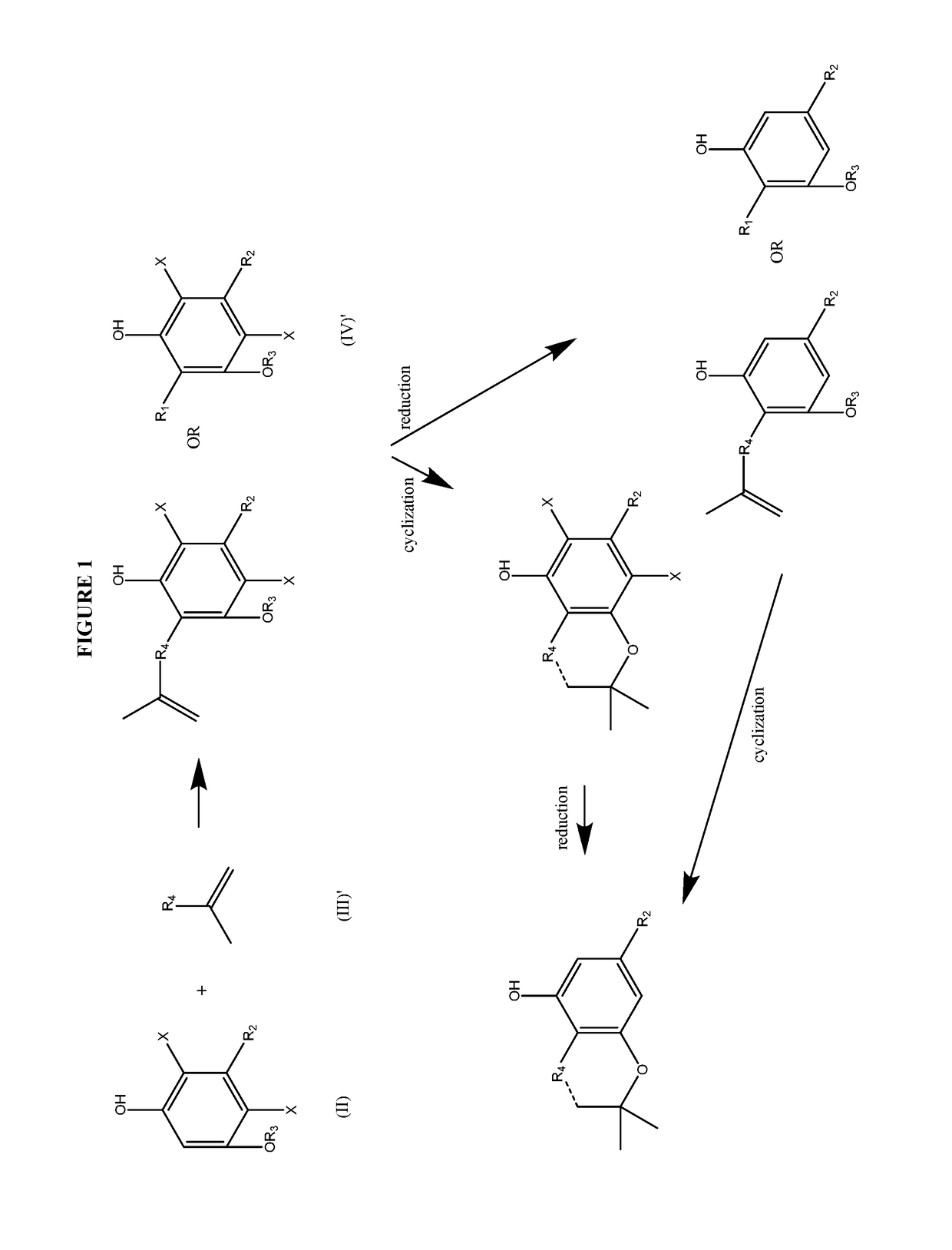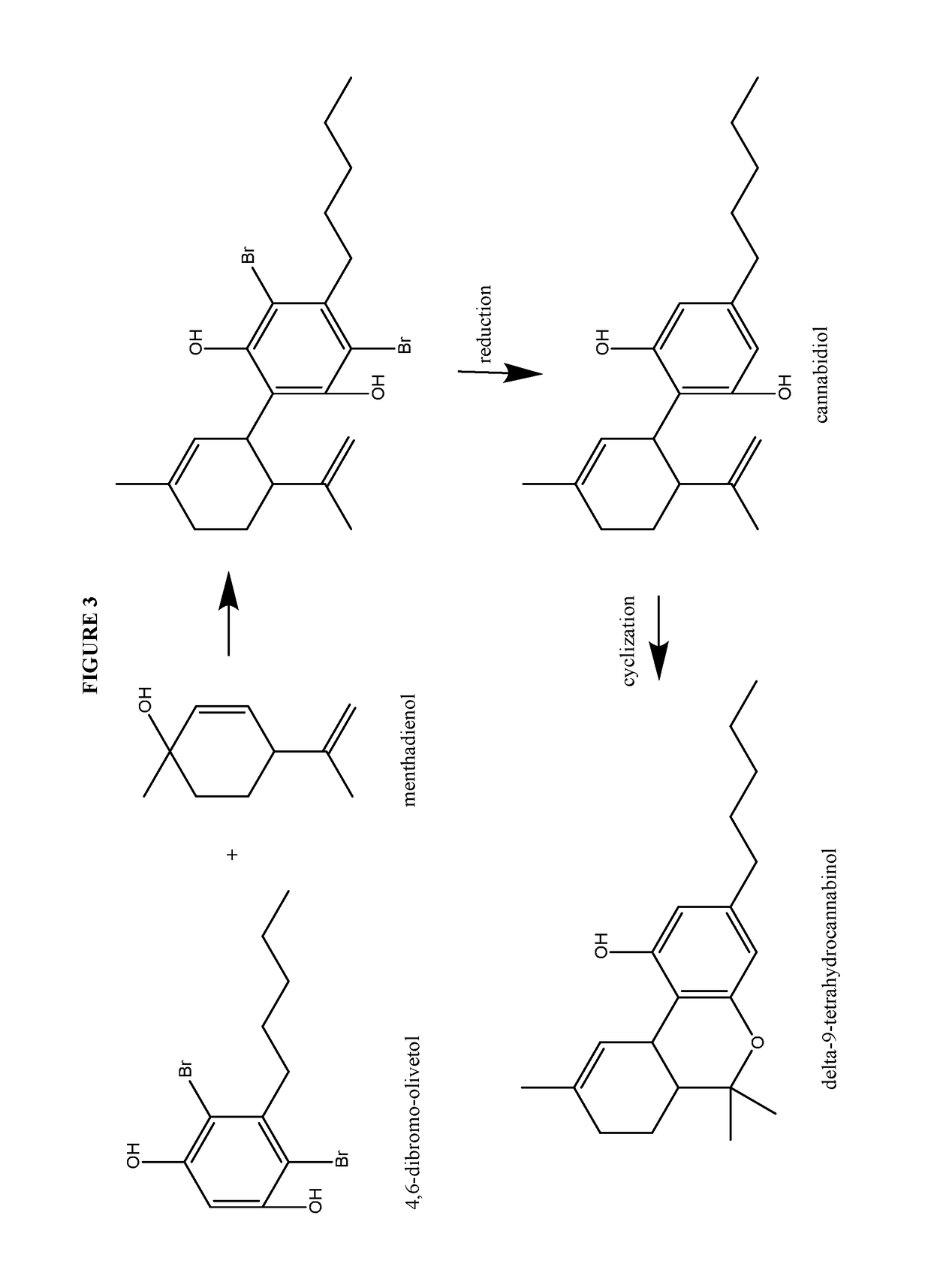Process for the production of cannabidiol and delta-9-tetrahydrocannabinol
a technology of delta-9-tetrahydrocannabinol and cannabidiol, which is applied in the preparation of organic compounds, metabolism disorders, organic chemistry, etc., can solve the problems of difficult or impossible separation and purification, formation of significant amounts of unwanted cannabidiol isomers along with cannabidiol, etc., and achieves low yield, poor selectivity, and high yield.
- Summary
- Abstract
- Description
- Claims
- Application Information
AI Technical Summary
Benefits of technology
Problems solved by technology
Method used
Image
Examples
example 1
of Cannabidiol from 4,6-dibromo-Olivetol
[0262]Cannabidiol, or (1′R,2′R)-5′-methyl-4″-pentyl-2′-(prop-1-en-2-yl)-1′,2′,3′,4′-tetrahydro-[1,1″-biphenyl]-2″,6″-diol, was prepared according to the present disclosure.
[0263]
[0264]Under a N2 atmosphere, 4,6-dibromo-olivetol (20.08 g, 59.40 mmol), magnesium sulfate (20.00 g, 164.5 mmol, 2.77 equiv.) and para toluene sulfonic acid monohydrate (5.76 g, 29.8 mmol, 0.50 equiv.) were suspended in CH2Cl2 (187.4 g) and cooled to between about −15 to −20° C. To this white suspension a clear solution of menthadienol (11.72 g, 76.99 mmol, 1.30 equiv.) in CH2Cl2 (55.13 g) was added dropwise over 6 hours. After stirring overnight at −15° C., the suspension was quenched with water (200.6 g). NaHCO3 (5.01 g, 59.6 mmol, 1.00 equiv.) was added in portions and the mixture was stirred for about 10 to 30 min at room temperature. The layers were separated and the aqueous layer was re-extracted with CH2Cl2 (50.1 g). The organic layer was concentrated to dryness...
example 3
y of Di-Halo Protection of Olivetol
[0287]The use of bromide, chloride and iodide was investigated as providing di-halo protection to 5-propylbenzene-1,3-diol [5], the C3-olivetol analogue.
[0288]Adding Bromide as Protection Group:
[0289]The bromination of [5] towards 4,6-dibromo-5-propylbenzene-1,3-diol [6] was performed as shown in FIG. 5. At −30° C., a solution of 0.25 g of [5] in 6 ml DCM was treated with 2.0 eq. of bromine. During cooling of the initial starting material solution, a sticky oil had formed at the bottom of the flask which hindered proper stirring. Also, the bromine was added using a syringe. The low temperature inside the reaction flask caused the bromine to solidify in the needle and blocked it. In a subsequent experiment, a bigger stirring magnet was used and the bromine was added as a solution in DCM using a dropping funnel in 10 minutes. After stirring for an additional 10 minutes, the reaction mixture was poured into a cold aqueous sodium thiosulfate solution. ...
example 4
of Dibromo-Olivetol with Other Olefins
[0345]The coupling of dibromo-olivetol with other olefins was performed. Dibromo-olivetol was coupled with the compounds in FIG. 8, including cyclohexene, octane, cyclohex-2-enol and linalool. A mixture of dibromo-olivetol (250 mg), the olefin to be coupled (1 eq.), magnesium sulfate (2.5 eq.) in DCM (2.5 mL) was treated with p-Tos-OH (0.5 eq.) at room temperature. After stirring for 2 hours, no conversion was observed with LC-MS, except for the experiment in which cyclohex-2-enol was used as coupling partner.
[0346]Using cyclohex-2-enol, full conversion into a new product was observed. After a simple aqueous work-up, the experiment with cyclohex-2-enol as coupling partner yielded 223 mg of a brownish oil with a purity of 94% according to LC-MS. In the mass trace, a mass of [M−H]=417 was found. Combined with the structural data obtained from the 1H-NMR spectrum it is believed that the formed compound is (S)-3,5-dibromo-4-pentyl-1′,2′,3′,4′-tetrah...
PUM
| Property | Measurement | Unit |
|---|---|---|
| pKa | aaaaa | aaaaa |
| Temperature | aaaaa | aaaaa |
| Temperature | aaaaa | aaaaa |
Abstract
Description
Claims
Application Information
 Login to View More
Login to View More - R&D
- Intellectual Property
- Life Sciences
- Materials
- Tech Scout
- Unparalleled Data Quality
- Higher Quality Content
- 60% Fewer Hallucinations
Browse by: Latest US Patents, China's latest patents, Technical Efficacy Thesaurus, Application Domain, Technology Topic, Popular Technical Reports.
© 2025 PatSnap. All rights reserved.Legal|Privacy policy|Modern Slavery Act Transparency Statement|Sitemap|About US| Contact US: help@patsnap.com



